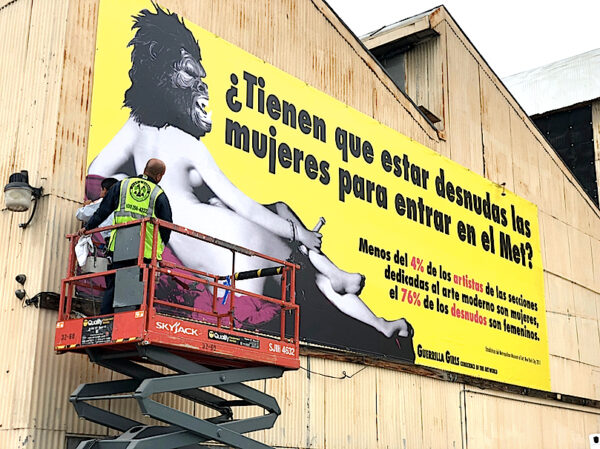
Guerrilla Girls, Spanish language banner in Los Angeles, 2018. It was also used in Spain and Latin America. Copyright © Guerrilla Girls. Photo source: https://www.guerrillagirls.com/projects
Commencing in 1985, a group of women artists and activists anonymously donned gorilla masks and began waging asymmetrical warfare against the exclusionary powers of New York City’s art establishment. Their struggle spread across the country, and to art metropolises around the world, including Quebec, Mexico City, Quito, Buenos Aires, São Paulo, London, Bilbao, Madrid, Rotterdam, Reykjavik, Moscow, Venice, Athens, Istanbul, Tokyo, and Shanghai. This article emphasizes the early history and work of these masked warriors, known as the Guerrilla Girls (GG), and their legacy. Their ongoing struggle, fought with words and images, has served to raise issues of diversity and inclusion and to inspire artists and activists around the globe, both within and beyond the world of art.
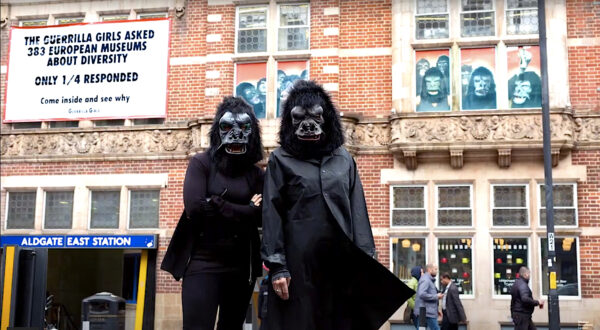
Guerrilla Girls in front of banner and photos at Whitechapel Gallery, London, 2016. The names of the museums that ignored their questionnaire were placed on the floor, where visitors walked on them. Copyright © Guerrilla Girls. Photo source: screen grab from “Guerrilla Girls – 1985-2017.”
The Guerrilla Girls have been featured in many Texas exhibitions. Most recently, the Nasher Sculpture Center in Dallas featured a display of pieces from GG portfolios as a component of its Mixtape exhibition of permanent collection works. Guerrilla Girls: Takeover, a virtual exhibition, has also alighted on the Nasher website, where it can be seen through January 2, 2022.

Guerrilla Girl banner in Istanbul, which predicts the future of Turkish women artists by reading Turkish coffee grounds, 2006 (made for an exhibition at the Istanbul Modern Museum). Copyright © Guerrilla Girls. Photo source: screen grab from Guerrilla Girls – 1985-2017.
Kynaston McShine’s International Survey at MoMA
A single exhibition and the hubris of its curator set this all-female army in motion. Kynaston McShine, Senior Curator in the Department of Painting and Sculpture at the Museum of Modern Art (MoMA) in New York City, organized an exhibition in 1984 called An International Survey of Recent Painting and Sculpture (May 17-August 7). This exhibition — the museum’s first major international survey since 1970 and the only one for the next 30 years — featured 195 works from 17 countries by 165 artists who had established their reputations after 1975. But only 13 of these artists were women. As Roberta Smith noted in McShine’s 2018 New York Times obituary: “That ratio so outraged a group of female artists that they founded the Guerrilla Girls.” The exhibition’s catalogue, checklist, press materials, and a comprehensive archive of installation shots can be accessed here.)
The Guerrilla Girl known as Käthe Kollwitz paraphrased a McShine comment in a 1995 book that has him adding insult to injury: “any artist who wasn’t in the show should rethink ‘his’ career” (Guerrilla Girls, Confessions of the Guerrilla Girls, 1995).
GG Frida Kahlo (in whose loft the group formed) said it essentially the same way: “Then Kynaston McShine, the curator of the show, said to the press, ‘Anyone who’s not in my show should rethink his career’” (Archives of American Art (AAA), oral history interview, Judith Olch Richards with Guerrilla Girls Frida Kahlo and Käthe Kollwitz, January 19; March 9, 2008).
Variations of these quips are often referenced in subsequent Guerrilla Girls literature, usually as a partially verbatim quote, as in a 2018 article in artnet news and a 2021 article “The Guerilla Girls—Biography and Legacy,” in The Art Story.
Some sources, including the Tate in “Who are the Guerrilla Girls?,” also convey the impression that McShine uttered something to this effect multiple times. One source for multiple utterances (on McShine’s part) is GG Kollwitz’s 2007 interview with Elizabeth Stark in Fringe, a publication whose existence was inspired by the Guerrilla Girls. Kollwitz told Fringe that McShine “gave interviews saying that any artist who wasn’t in the show should rethink ‘his’ career.”
I planned to cite an original source for the McShine quote that included the pronoun “his,” but I did not find one anywhere. Before the exhibition opened and before the full list of artists was released, the curator did, however, give the following quote to Michael Brenson of the New York Times: “I think that some people can benefit from not being in the show.” He continued: “They will have to think about their work.” On its face, this is an extremely obnoxious statement. McShine positions himself as such a supreme arbiter of taste that his own acts of exclusion should compel artists to reevaluate their work. With the passage of time, could this quote have been distorted into the even more offensive and gender-specific one utilized by GG Kollwitz? Everyone makes mistakes, and Guerrilla Girls have garbled the statistics for McShine’s International Survey in videos and publications (GG Kollwitz, for instance, cites 169 artists in Confessions of the Guerrilla Girls as well as in the Fringe interview, and that number is repeated in the literature). In any case, McShine became notorious for refusing interviews.
Born in Trinidad, McShine was reportedly the first person of color to work as a curator at a leading art museum in the U.S. (he was hired at MoMA in 1968). Some ambiguous quotes by GG artists (when they were discussing women artists) sometimes give the impression that all of the artists in McShine’s survey were White. According to the GG, all of the women artists in the survey were White. Artists of color constituted an even lower percentage than female artists. In a 2020 article in Daily Art Magazine, Jennifer S. Musawwir puts the number of artists of color at eight.

Susan Miller (left) and Maria Elena Gonzalez (right) holding banner that reads: “MoMA Do Only White Men Make Art?” as part of the WAVE (Women Artists Visibility Event) a.k.a Let MoMA Know protest, June 15, 1984. They are in front of the former site of the midtown public library, across the street from MoMA. The protest was organized by artists Sabra Moore and Betsy Damon (both artists) and art historian Annie Shaver-Crandell, through the New York City chapter of the Women’s Caucus for Art. Clarissa Sligh, who has archived her 21 photographs of the demonstration at Duke University’s Sallie Bingham Center for Women’s History and Culture, is endeavoring to identify all of the participants she photographed at the demonstration. Copyright © Clarissa Sligh. Photo source: Clarissa Sligh
Guerrillas become Gorillas
How, exactly, did the Guerrilla Girls begin? In 1984, the Women’s Caucus for the Arts sponsored a protest outside of MoMA (see details in the caption above) to decry the poor representation of female artists in the International Survey exhibition. Seven future Guerrilla Girls participated in the protest, but they were frustrated that no one passing by seemed to care about their message. GG Kahlo notes in the 2008 AAA interview that no one honored their picket line. These Guerrilla Girls-to-be realized “there had to be a better way, a more media savvy, more contemporary way to get through to people” (quoted in “The Guerilla Girls — Biography and Legacy” article linked above).
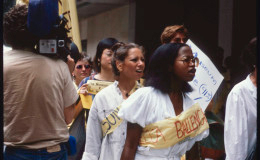
Margo Machida (left-center with glasses holding a yellow sign) is the only identified protester in this photograph, protest outside MoMA, June 15, 1984. Copyright © Clarissa Sligh. Photo source: Clarissa Sligh
The artists and activists held meetings to try and find a better way to reach people. They discussed guerrilla war tactics. Guerrilla is the diminutive form of the Spanish word guerra (war). Coined in connection with the Peninsular War (Napoleon invaded Spain and Portugal, defeated their regular armies, but was besieged by partisan irregular forces), guerrilla warfare connotes popular and mobile resistance to superior invading armies or occupying forces.
Since English speakers usually pronounce guerrilla and gorilla in a similar manner, it is not surprising that one of the original group members wrote “gorilla” instead of “guerrilla” in her notes. This misapprehension of the group’s nom de guerre inspired its masque de guerre. In addition to the linguistic slippage between guerrilla and gorilla, and the pleasing homonymity of guerrilla, gorilla, and girl, the enormous gorilla masks that members placed over their heads dwarfed their bodies, and thus invoked the greatest ape of all, King Kong. (In some gorilla subspecies, males are twice as big as females, so once can read these over-sized masks as implicitly — or at least potentially — male.) These huge masks were melded onto the bodies of smaller-scaled “girls” (to used the group’s eponymous term), which served to invoke Kong’s inamorata Fay Wray — in a fortuitously and comically Frankensteinian marriage of forms. GG Kollwitz says the masks “gave us our ‘mask-ulinity’” (Confessions of the Guerrilla Girls, 1995).

Two Guerrilla Girls wheat pasting posters by streetlight in New York City, 1990. Initially GG Kahlo and Kollwitz wheat pasted without a face covering. They subsequently used ski masks before the spelling error gave them the idea to use gorilla masks. Their secret wheat pasting formula? Use a squeegee and an admixture of Elmer’s Glue. The act of wheat pasting in gorilla masks was evidently a very limited and short-lived phenomenon. The group eventually paid men to wheat paste their posters. Copyright © Guerrilla Girls. Photo source: screen grab from Guerrilla Girls – 1985-2017 video.
These guerrillera (female warrior) uniforms provoked laughter as a strategy. As one Guerrilla Girl noted in a oft-quoted quip: “We discovered early on that if you could make someone who disagreed with you laugh, then you had a hook inside their brain. Once you were in there, you just might be able to change their minds about things” (Guerrilla Girls 1985 – 2017 video).
Crucially, the masks initially provided anonymity, which prevented professional retaliation against group members. But by 1991, as GG Alma Thomas notes, an affiliation with the group would have benefited a female artist’s career (Archives of American Art, oral history interview, Judith Olch Richards with Guerrilla Girls Jane Bowles and Alma Thomas, May 8, 2008).
In the video called The Guerrilla Girl’s Guide to Behaving Badly (Which You Have to do Most of the Time in the World as we Know It) (henceforth referred to as GGGBB), one member gave this exhortation:
BE ANONYMOUS: Our anonymity, for example keeps the focus in the issues and away from our personality. The mystery of who we might be draws lots of attention for the issues we promote. Plus, you won’t believe what comes out of your mouth when you are wearing a gorilla mask.
The gorilla mask served as a hulking alter ego. As GG Lee Krasner puts it: “We joined a long tradition of (mostly male) masked avengers like Robin Hood, Batman, The Lone Ranger, and Wonder Woman” (Confessions of the Guerrilla Girls, 1995).
When group members were in the process of being interviewed, however, it served their interests to also have an individual identity within a larger cloak of anonymity. Coincidentally, on the day they were taping NPR’s Fresh Air, the artist Georgia O’Keeffe died. This inspired group members to utilize the names of — and simultaneously to commemorate the memories of — deceased artists, writers, and other creative women.
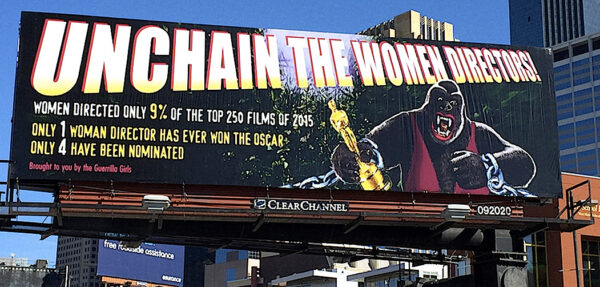
Guerrilla Girls, UNCHAIN THE WOMEN DIRECTORS, 2006. This billboard — a particularly direct, if gender-fluid invocation of King Kong — was displayed in Hollywood during Oscars month. Copyright © Guerrilla Girls. Photo source: https://www.guerrillagirls.com/projects
Ethnic Diversity and Tensions within the Group
According to the “The Guerilla Girls—Biography and Legacy” article cited above, the group was initially focused on the representation of women artists in New York; it “responded to criticisms of being primarily concerned with ‘White feminism’” and, as a consequence, increasingly addressed racial disparities. As is evident from Clarissa Sligh’s photographs, the protesters outside of MoMA in 1984 (seven of which became the first Guerrilla Girls), were already concerned with racial diversity, and they themselves were racially diverse. GG membership was by invitation only, and its founding members were all White (a Black woman who became GG Alma Thomas thinks she received an early invitation, but family obligations prevented her from joining until later).
According to GG Gertrude Stein (in collaboration with nine other group members), the group’s lack of ethnic diversity “was a recurring issue,” and several women of color dropped out after attending a few meetings due to the hierarchical control exerted by GG Kahlo and Kollwitz. Stein writes that several women of color who had quit the main GG group joined her group, called Guerrilla Girls Broadband (Gertrude Stein, et al., “Guerrilla Girls and Guerrilla Girls BroadBand: Inside Story,” originally published in Art Journal, 2011, which can be downloaded here.)
Anna C. Chave examines the group’s ethnic make-up and discusses how it handled racial issues in “The Guerrilla Girl’s Reckoning” (Arts Journal, 2011), which can be downloaded here. Chave notes tensions and objections to the use of the gorilla mask, due to racist stereotypes that link apes and monkeys to Blacks. She quotes Black GG Alma Thomas and Latina GG Julia de Borgos (both interviewed by the AAA in 2008 and discussed below).
Suzanne Lustig states that for some members, the gorilla mask eventually “become a projection of racist fantasies and a perpetuation of the sexual allure of the veiled woman.” She cites the statement a Black Guerrilla Girl made to Elizabeth Hess about unintended racial assumptions: “The mask becomes a physical and psychological burden at times, limiting our functions. It doesn’t dictate our behavior, but it affects our bodies and minds. When I put on the mask, I look the way some people see me every day, unconsciously.” GG Thomas told the AAA in 2008 that she objected to the mask, though nothing else would have been as powerful:
I myself always objected personally to the mask because the mask had such a terrible connotation for black women, the gorilla image.
It was too close to home, but I didn’t want to wear the mask. I never wanted to wear the mask, but I always had to bow to the symbology that the Girls had locked into that was so powerful. I mean, there was nothing that you could ever replace this gorilla mask with that would be as powerful as it was.
GG Thomas frequently went on speaking gigs for the group. Their act included tossing bananas to the audience. She told the audience that she was Black, but they did not believe her, thinking “that was part of the performance.”
GG de Borgos pointed out: “this group had to have been started by White women” because women of color would have avoided the gorilla mask due to racist associations of Blacks with animality and subhuman status. She pointed out that “the very fact that they felt comfortable using this gorilla mask was part of the White privilege” (Archives of American Art, oral history interview, Judith Olch Richards with Guerrilla Girls Julia de Burgos and Hannah Höch, May 8, 2008).
GG Kahlo provides this defense of the group’s ethnic diversity in her 2008 AAA interview:
By our second year, we were a very diverse group, especially compared to the rest of the art world, which was practically all White male artists helped by White females (gallery owners, critics, curators and dealers). We were young, old, lesbian, straight, and also artists of color. Our members of color always thought they were not enough, and that was a fair sentiment. But we did our best. We were miles ahead of the rest of the art word and other artist groups. Our first poster about Black women artists came out in 1986, one year after we started. We were also at all levels of art world success: some well-known, some obscure. (I have removed the parentheses that mark additions subsequent to the recording)
In my examination of the Guerrilla Girl’s early works below, I am attentive to works that address racial disparities and other political issues beyond gender equity. The Guerrilla Girls increasingly addressed a global audience with a wide range of issues beyond the art world.
Colette Copeland conducted a Guerrilla Girl interview in 2018 in Glasstire that features recent work, including content critical of Trump and other contemporary figures.
The “Banana Split”
Musawwir (in the 2020 article cited above), GG Kahlo (in her AAA interview), and GG Stein, et al. (in the 2011 article cited above) discuss the “banana split,” in which the group fractured into three legally recognized entities.
Though he garbles the group’s origins in a short 2005 New Yorker article, Jeffrey Toobin discusses the 2003 lawsuit that formalized the split. It was brought by GG Kahlo and Kollwitz (these original GG members were friends before the formation of the group, and they lead its successor group) against other group members. In their complaint, GG Kahlo and Kollwitz (who were compelled to reveal their real identities) claimed to be the “guiding forces” behind the group. In a letter to Glasstire, GG Kahlo notes that Toobin, who “has a reputation for ‘revealing’ too much,” secured the court filings and disclosed their true identities.
The GG’s early work has a uniform design and seems to speak with a single voice. I always wondered if it had been produced by a single person or a very small group. The lawsuit seemed to confirm that impression. In the 2008 AAA interview, GG Kahlo and Kollwitz claimed that they wrote the copy together. Kollwitz did most of the graphics, while Kahlo was the primary researcher. Other members were unhappy that GG Kahlo and Kollwitz had lifted the veil of anonymity, claimed and copyrighted group work, and sued them. The group had previously praised the contributions made by its membership, even those by short-term members.
Group representatives were often cagy when asked for specific membership figures — especially GG Kalho, who implied a mythic multitude — as GG Thomas notes in her AAA interview. In response to Cindy Sherman’s question about the group’s size in Interview in 2012, a GG representative explained: you can’t be a huge group and do the kind of posters, billboards, books, and targeted actions we’ve done.” Stein et al., reveal that there had only been about 100 members between 1985 and 2000. In a letter to Glasstire, GG Frida Kahlo specifies that there have been a total of 65 group members. GG Thomas says the core membership stayed relatively intact, while new members often did not stay long.
GG Kahlo and Kollwitz continue the original group as Guerrilla Girls. Guerrilla Girls On Tour is a theater group formed by GG Aphra Behn. GuerrillGirlsBroadband, formed by GG Gertrude Stein, does internet work.
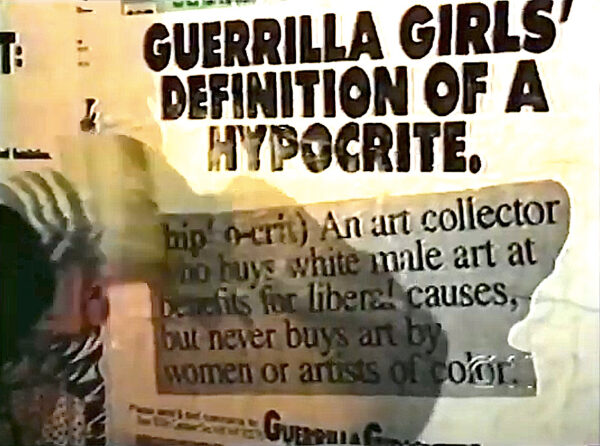
One last swipe of the wheat paste brush (by one of the two Guerilla Girls pictured above) on a poster decrying liberal collectors who do not buy works by women or artists of color, New York City, 1990. Copyright © Guerrilla Girls. Photo source: screen grab from Guerrilla Girls – 1985-2017 video.
On the Street
Street art is always most vital in its gritty, native context: overlaid on previous postings, and often torn, marked up, defaced, partially shriveled, pasted over, and in competition with colorful graffiti. That’s the life it was meant to have.
Better than any other street artists/activists of their era, the Guerrilla Girls understood how to make direct, powerful, and clear images that captured one’s attention. In a 1991 Arts Magazine article, Susan Tallman noted that most of the group’s graphics had “the studiedly undesigned look of 1970s conceptual art… set in that most generic of typefaces, Helvetica.” (GG Frida Kahlo notes that the GG typeface is in fact Futura Extrabold Condensed.) She adds that their image — including the gorilla masks — “could not have been designed more effectively by a Madison Avenue P.R. man.” It was a preternaturally clear, anonymous style, crafted by anonymous provocateurs.
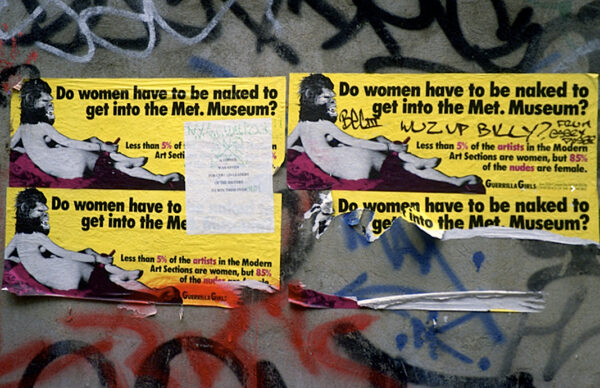
Multiple Guerrilla Girls posters in context, 1989. Photo source: https://www.guerrillagirls.com/street-projects/
In comparison to the street, museums are sterile, sanitized, “polite” environments, where one can see a carefully encased object — much like a viewing at a wake. No one is going to run you over, or yell at you for standing still. On the street, however, everything pulses with energy. Trucks cause vibrations, cars and taxis whiz by — along with bicycles, skateboards, and who knows what else. On the street, the beholders of these works are also in motion, along with any number of other passers-by, walking, talking, and gawking in every direction. Steam is hissing out of vents, sirens wail in the distance, and there is usually a drum-beat of jackhammers that accompany partially grasped conversations in multiple languages. All the while, music wafts by from all directions. Food carts, diners-on-the-run, heavily-perfumed pedestrians, wandering dogs, vehicle exhaust, and the musk of decay create a bewildering array of scents and aromas. Yet the Guerrilla Girls consistently managed to make images that broke through this perpetual visual, aural, and olfactory overload, this constant, multi-sensory din more complex than a thousand people talking at once.
The Guerrilla Girls, 1985-1991
My review of the group’s early work is also a trip down memory lane, as I recall encountering these powerful works, one-by-one — and sometimes en masse, papered over an entire section of wall.
My primary sources for chronology, images, and commentary are: “The Guerrilla Girls’ Complete Chronology”; “Posters, Stickers, Billboards, Videos, Actions: 1985-2021”; the AAA GG Frida Kahlo and Käthe Kollwitz interview cited above, 2008; and Suzanne Lustig, under the direction of Kathryn Kish Sklar, “How and Why Did the Guerrilla Girls Alter the Art World Establishment in New York City, 1985-1995?,” 2002.
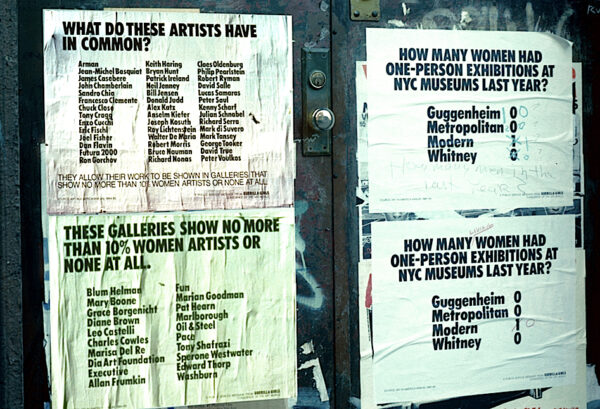
Guerrilla Girls, three early posters wheat-pasted on doors, New York City, 1985. Copyright © Guerrilla Girls. Photo source: https://www.guerrillagirls.com/projects
The group sprang to life by wheat pasting two posters in 1985. What do These Artists Have in Common? (upper left) listed 42 male artists chosen solely for their prominence. The Guerrilla Girls realized that some of the male artists didn’t like one another. The GG called them out for the only thing they had in common: allowing themselves to exhibit in galleries whose percentage of women artists is 10% or less. In the lower left corner of this poster, the Art in America Annual is listed as their source. The group already referred to itself as the “conscience of the art world.” The other GG poster produced at this time, These Galleries Show No More Than 10% Women Artists or None At All (lower left), called out the galleries themselves.
As GG Kahlo noted in the 2008 AAA interview: “We were in a period of time when everyone was saying, ‘Oh, you can’t change that. You can’t do anything about that.’ There had been these gains from the second wave of feminism, and then it had all backslid… we were really pissed off.”
The group’s first press release, dated May 6, 1985, featured a small image of these two posters and the following text:
Posters pointing to the inadequate numbers of women artists represented in leading New York galleries are appearing in SoHo streets, on walls, streetlamps and telephone booths. Two strongly worded posters drawing attention to the continuing discrimination against women artists are the work of a newly formed group calling itself Guerrilla Girls and preferring to conduct its campaign of information and public exposure without identifying its individual members. Guerrilla Girls plans to continue its campaign throughout the next weeks and next season, drawing attention to the retrograde attitudes toward women artists that characterize certain segments of the art world of the mid-80’s. Simple facts will be spelled out; obvious conclusions can be drawn.
Initially, the group neither planned nor envisioned a long-term, continuous existence. GG Kaho explains in her 2008 AAA interview: “It was nothing I ever planned. It just got so interesting, I could never leave it. And then it became a responsibility.” She also “really wanted to annoy” the clubby, “class-bound” art world. They had to be guerrillas and freedom fighters in order to annoy — and possibly scare — their adversaries.
GG Romaine Brooks says the group’s popularity and global reach was completely unexpected:
We just wanted to have a little fun with our adversaries and to vent a little rage. But we also wanted to make feminism (that “f” word), fashionable again, with new tactics and strategies. It was really a surprise when so many people identified with us and felt we spoke for their collective anger. We didn’t have the wildest notion that women in Japan, Brazil, Europe and even Bali, would be interested in what we were doing (Confessions of the Guerrilla Girls, 1995).
The third Guerrilla Girl poster (on the right side of the illustration above) highlighted the paucity of one-person exhibitions devoted to women at the city’s four leading art museums: a grand total of one.
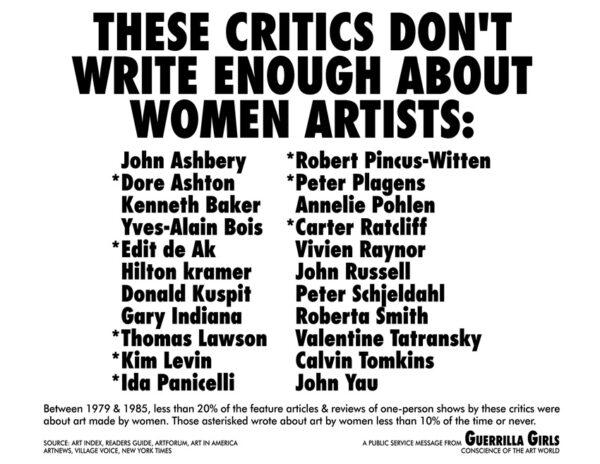
Guerrilla Girls, These Critics Don’t Write Enough About Women Artists, 1985, poster. Copyright © Guerrilla Girls. Photo source: https://www.guerrillagirls.com/projects
After targeting prominent artists, galleries, and museums, the Guerrilla Girls turned their attention to critics who wrote about women in feature articles and reviews less than 10% and 20% of the time (the former were marked by asterisks) between 1979 and 1985. This poster, called These Critics Don’t Write Enough About Women Artists, included some prominent female critics, such as Dore Ashton, Kim Levin, and Roberta Smith. It was the GG’s first poster to include the tag line “A public service message from Guerrilla Girls.”
Next, the Guerrilla Girls turned their attention to the New York Times in John Russell Thinks Things are Getting Better for Female Artists. They highlighted a rosy quote by John Russell and contrasted it with a chart that mapped reviews of one-person shows by women written by the Times’ critics between 1981 and 1984. 30% of Grace Glueck’s reviews treated women in 1981 (the highest percentage), whereas Hilton Kramer reviewed no shows by women in 1984 (the lowest percentage).
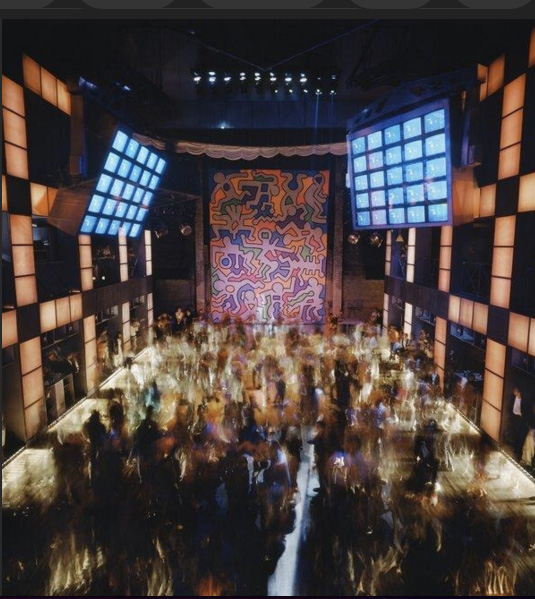
Palladium dance floor, with Keith Haring painting in the background, New York City, 1985. Photo source: https://camewiththeframe.tumblr.com/post/179132730312/the-nightclub-held-monthly-art-shows-featuring
In October of 1985, the Guerrilla Girls broke new ground by curating an exhibition for the first and last time. They also made an announcement poster and an exhibition poster for the exhibit, which took place at the newly opened mega-club called the Palladium, which I frequented at that time. Formerly an important live rock music venue, the club was opened by Steve Rubell and Ian Schrager (of Studio 54 fame) as their post-prison debut. The space was designed by Arata Isozaki (his first completed design in the U.S.), and Paul Goldberger gave it a rave review in the New York Times, though he noted “it is rather as if Philip Johnson were to go to Japan to design not a skyscraper, but a geisha house.”
“Flash Gordon meets Luis Buñuel,” opined the Los Angeles Times in its review of the club. A huge Keith Haring painting backed the dance floor. Francesco Clemente decorated the club’s upper vestibule. A sizeable Jean-Michel Basquiat hung in the Michael Todd Room (the V.I.P. room), and an even bigger one extended the length of that room’s very long bar. The behind-the-bar Basquiat and another view of the Haring can be seen here. The Palladium showed Warhol and Robert Mapplethorpe pictures aplenty. But nothing upstaged Kenny Scharf’s electric-colored decorations. The Palladium, in short, was a behemoth, an especially clubby contemporary art museum. Trendy male art was its most highly visible calling card.

“On Oct. 17 the Palladium Will Apologize to Women Artists,” Palladium exhibition announcement poster wheat-pasted on wall, 1985. Photo source: https://documents.alexanderstreet.com/d/1000689328
The posters and stickers created by the Guerrilla Girls were primarily posted in SoHo and the East Village. In those days, artists and galleries inhabited the same neighborhoods. GG Kahlo and Kollwtiz recall wheat pasting posters on Friday nights, from midnight to three A.M., so the posters could greet Saturday morning gallery goers. Because of their strategic placement — frequently on exterior gallery walls and doors —these posters garnered considerable attention and stimulated lively discussions.
No doubt to some group members’ surprise, Palladium co-owner Ian Schraeger offered them the opportunity to curate a show of all-women artists at the club. Contrary to some accounts, the group did not criticize or approach the club directly. The idea came from Schraeger’s girlfriend, who was a friend of one of the Guerrilla Girls.
GG Kahlo notes in her 2008 AAA interview that prior to the Palladium exhibition, women’s shows in New York were regarded as “ho-hum, the Salon des Refuses” (a reference to the famous French exhibition in 1863 of works rejected from the official Salon). GG Kahlo explains that they wanted to storm the Palladium, and provide an altogether different experience: “We didn’t want that. We wanted to invade the establishment, invade the boys’ club, make a show of women artists sexy.”
GG Kollwitz recalls in the 2008 AAA interview that the poster reproduced above “really pissed the Palladium off. They called us up and chewed us out.” She adds that GG members laughed while they made an insincere apology.
On the GG online chronology, only this poster is listed. Neither this poster nor the one below are reproduced on the GG website.
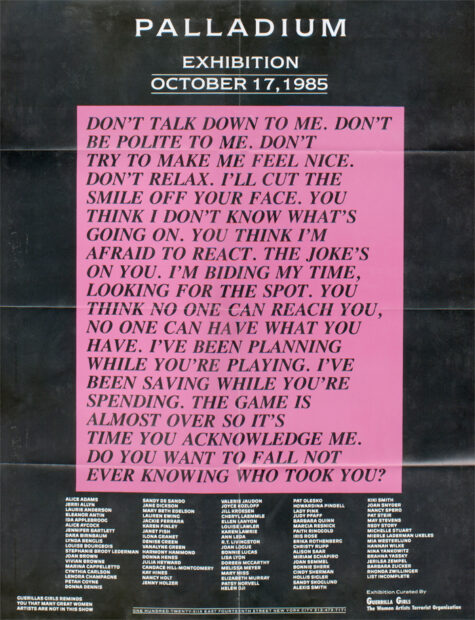
Palladium Exhibition” poster with Jenny Holzer text, October 17, 1985. Photo source: http://gallery.98bowery.com/2010/poster-1985-copy/
The weeklong exhibition curated by the Guerrilla Girls opened October 17, 1985. The invitation read: “Please join the Guerrilla Girls—the Women Artists Terrorist Organization for a reception for the exhibition that forever put to rest the following notions: (1) Biology is destiny, (2) There are no great women artists, (3) It’s the men now who are emotional and intuitive, and (4) Only men can show at the Palladium.”
The invitation’s text reflects the major influence that Linda Nochlin’s essay “Why Have There Been no Great Women Artists?” (1971) exerted on the group. Nochlin emphasizes the opportunities that have been afforded to men and denied to women, as well as the power of the institutions that control these opportunities.
86 women artists are listed on the exhibition poster, which notes that the list of participating artists is incomplete. It includes such well-known artists as Laurie Anderson, Jennifer Bartlett, Lynda Benglis, Louise Bourgeois, Joan Brown, Karen Finley, Jenny Holzer, Elizabeth Murray, Faith Ringgold, Erika Rothenberg, Alison Saar, Cindy Sherman, Kiki Smith, Nancy Spero, and Hannah Wilke. According to Lucy Lippard, 150 works by 85 women were in the exhibition. Many were probably late additions, since a review by Demetria Daniels notes “more than 50 women artists.” GG Kollwitz told Fringe in 2007: “We included hundreds of women, but still felt badly that we hadn’t included more.” In the 2008 AAA interview, Kollwitz says the number of artists was “probably” a hundred.
A notice at the bottom left of the poster reads: “Guerrilla Girls reminds you that many great women artists are not in this show.” The credit in the lower right reads:
Exhibition Curated By
GUERRILLA GIRLS
The Women Artists Terrorist Organization
The exhibition caused several Guerrilla Girls to resign from the group in protest. The very act of taking up an idea that had come from the club’s management was controversial. Some saw a conflict between the group’s origins, which were predicated on exposing the exclusion of women, and its formal participation in a curatorial process that entailed exclusion. Some group members thought it was wrong to ever curate in a manner that would exclude other women (as opposed to an open call, wherein anyone could participate). One Guerrilla Girl told Elizabeth Hess: “We couldn’t beat the system and join it at the same time. . . The group was moving in the wrong direction.” The Guerrilla Girls consistently made quantitative rather than qualitative analyses. (A singular exception was GG Kahlo’s and Kollwitz’s opposition to the use of the name Guerrilla Girls by unaffiliated women in other cities whose work they deemed inferior: that was one of their rationalizations for utilizing copyright.)
As GG Kollwitz observed in the 2008 AAA interview: “we realized that that exhibit was the worst possible thing we could ever do… we realized we will never, ever do an exhibition again… We represent all women artists, not a selection of them. We don’t ever want to be in a position of saying, ‘You, not you; you, not you.’”
A comment made by the GG to Interview in 2012 surely reflects the experience of this exhibition: “We decided early on to never make choices between living artists because we support inclusion, not exclusion.”
It is the first exhibition listed on the group’s website, which otherwise contains exhibitions of their own work. Also see the “It Came with the Frame” blog on tumblr for additional information and images.
This exhibition poster incorporates a Jenny Holzer text (in pink). The Holzer (as a small, discrete sheet) was wheat pasted all over walls and sidewalks in lower Manhattan. Even in its often faded, abraded, and scratched state, it packed a wallop. I especially enjoyed watching people read it on the sidewalk. They often shuddered and looked behind them — just to make certain that the text’s author wasn’t about to take them out.

Guerrilla Girls, Its Even Worse in Europe, 1986, poster. Copyright © Guerrilla Girls. Photo source: https://www.guerrillagirls.com/projects
During their speaking engagements abroad, the Guerrilla Girls noticed that European women artists were even more marginalized than those in the U.S. They responded with this brilliant poster, which grabbed attention through its blankness. The GG enlarged the size of their logo, confident that the mere fact of their authorship made its message plain.

Guerrilla Girls, Dearest Art Collector, 1986, poster. Copyright © Guerrilla Girls. Photo source: https://www.guerrillagirls.com/projects
This faux-naïve and hyper-feminine note, executed in juvenile cursive on pink paper, replete with a frowning daisy at the top, absolutely drips sarcasm. The faux-naïve author seemingly expects that merely pointing out inequities will be sufficient to rectify them. The Guerrilla Girls website offers this laconic commentary: “Boys will buy boys.”
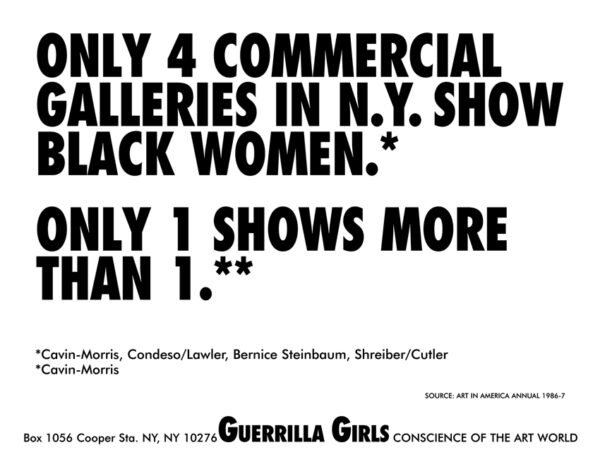
Guerrilla Girls, Only 4 Commercial Galleries in N.Y. Show Black Women, 1986, poster. Copyright © Guerrilla Girls. Photo source: https://www.guerrillagirls.com/projects
The statistics for Black women artists were particularly grim. The Guerrilla Girls website states: “These statistics shocked and embarrassed the world.” This is the first GG work to specifically address people of color. Race would be a primary focus of the group’s work in 1987.

Guerrilla Girls, Guerrilla Girls Review the Whitney, 1987, poster. Copyright © Guerrilla Girls. Photo source: https://www.guerrillagirls.com/projects
The Guerrilla Girls Review the Whitney exhibition resulted from an invitation from the Clocktower Gallery in New York City in 1987. Instead of curating an alternative exhibition concurrent with the Whitney Biennial — which had been the expectation of the host institution — the Guerrilla Girls made an analytic exhibition, one that subjected the recent biennials mounted by the Whitney Museum of American Art to close scrutiny and mockery. One Guerrilla Girl described the show as “an exhibition of information exposing the museum’s pathetic and worsening record on women and artists of color” (Confessions of the Guerrilla Girls, 1995).
The Guerrilla Girls sometimes referred to their gender tallies as “banana counts.” In their poster for the exhibition, a mini-skirted Guerrilla Girl punningly points to a bent, naturally-white, half-peeled banana.
The Guerrilla Girls give this summation of the Whitney’s record:
No black woman had ever been chosen for a Whitney Biennial since 1973; Of the 30 non-white artists who had been in the biennials since 1973, only 3 have had work acquired for the museum collection; More than 70 artists had been chosen for more than one Biennial, only one of them was nonwhite; the Whitney’s acquisition of art by women had never exceeded 14% in any year. In 1984 only 9% of its acquisitions were of women artists. The work of men chosen for the Biennial was acquired by the museum twice as often as the work of women chosen for the Biennial; More than 70% of the acquisitions of art by women in the Biennials up until then had taken place in the 1970s; The museum already owned works by 12 of the 43 artists in the 1987 Biennial show; Between 1982 – 1987 there had been only one solo show of a woman artist at The Whitney.
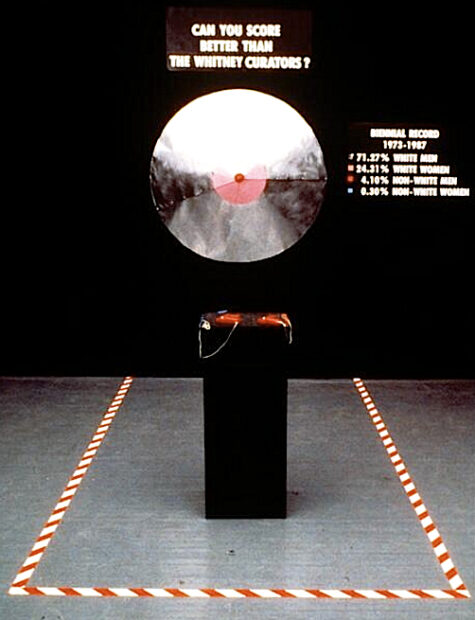
Guerrilla Girls, Can You Score Better than the Whitney Curators? in Guerrilla Girls Review the Whitney, 1987, sculpture. Copyright © Guerrilla Girls. Photo source: https://twitter.com/guerrillagirls/status/446786813626023936
GG Gertrude Stein et al. discuss “a wonderful sculpture” made by Black GG Harriet Tubman called Can You Score Better than the Whitney Curators? displayed in their Whitney “review”:
It consisted of a metal cone breast, the boob part of which represented the 72.29 percent white men in Whitney biennials, 1973 to 1987; the aureole represented the 24.31 percent white women shown during the same period; the nipple 3.1 percent nonwhite men; and the hole, 0.3 percent nonwhite women. Visitors to this exhibition in The Clocktower in Lower Manhattan were invited to shoot suction darts at the boob target.
In a 1987 review in New York titled “The Whitney’s Girl Trouble,” Edith Newhall called the exhibition “their most ambitious attack to date.” Roberta Smith enthusiastically recommended the GG’s anti-Biennial in the New York Times:
Alternatively irreverent, informative and just plain angry, this exhibition should be required viewing for anyone interested in the art world’s inner machinations.
A mole inside the museum provided information that the GG used to assess the trustees’ corporate connections and to point out curatorial conflicts of interest.
In 1987 in Kassel, Germany, the Guerrilla Girls made an appearance at Documenta, the international exhibition that is staged there every five years. They handed out a calling card that read: “Why in 1987 is Documenta 95% White and 83% Male?”
Their next poster, one called What’s Fashionable, Prestigious & Tax Deductable? Discriminating Against Women and Non-White Artists, listed exhibitions in recent years that primarily featured White male artists. They also listed the sponsoring corporations, foundations, and government agencies.

Guerrilla Girls, We Sell White Bread, 1987, sticker. Copyright © Guerrilla Girls. Photo source: https://www.guerrillagirls.com/projects
Like many of the group’s best graphics, this one is astonishingly simple. The group’s website explains the rationale behind this sticker: “Art galleries are stores, and in New York, all they sell is white bread.” White male artists are likened to a bland, inadequate diet, one that is not only tasteless, but also insufficient for sustenance. These admonishing stickers were applied to gallery windows and doors as an indictment of their product. One can also view these galleries as “White-bred” establishments that perpetuate White privilege.
One Guerrilla Girl poster in 1987 queried, “When Racism & Sexism Are No Longer Fashionable, What Will Your Art Collection Be Worth?” It listed a sizeable roster of women artists and helpfully pointed out: “You Can Buy A Whole Collection Of Work By Women Artists For The Price Of One Painting By A Famous White Guy.”
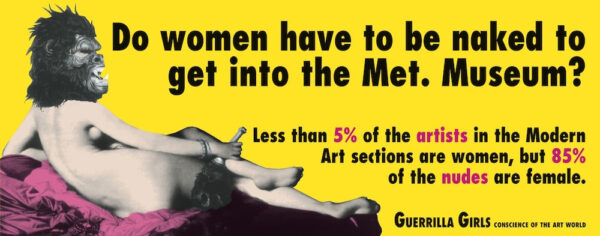
Guerrilla Girls, Do women have to be naked to get into the Met. Museum?, 1987, poster. Copyright © Guerrilla Girls. Photo source: https://www.guerrillagirls.com/projects
The Guerrilla Girls created their most famous work by collaging one of their signature gorilla masks over the head of the Neoclassical artist Jean-Auguste-Dominique Ingres’ La Grande Odalisque (1814). Ingres’ world-famous Odalisque is the quintessential Western image of a passive and exotic “Orientalist” concubine. In popular culture, the chest-thumping body language of angry gorillas is very familiar from King Kong movies and other sources. So it is extremely jarring to see a hairy, screaming gorilla head (implicitly male) atop a nude and recumbent human female body. The poster’s text was suggested by a “weenie count” at the Metropolitan, where the GG determined that “less than 5% of the artists in the Modern Art Sections are women, but 85% of the nudes are female.”
The Public Art Fund in New York had commissioned a work from the Guerrilla Girls for a billboard, but they rejected this image. According to GG Kahlo in the AAA interview, they said: “We think you should work on this a little bit more because the idea is not very clear.” GG Kahlo adds: “it was pretty clear to us that they [The Public Art Fund] were not prepared to attack a major institution.” So the group decided: “to hell with them; we weren’t going to be censored; we weren’t going to redo it to make them accept it.”
Undeterred, the Guerrilla Girls had the brilliant and strategic idea to buy advertising space on New York City buses, where they placed the image as if it were a commercial ad on buses in lower Manhattan. While billboards are constrained to the margins of the city, buses traverse the major avenues. GG Kahlo reports that the image garnered a great deal of press. When they tried to renew the ad, the Metro Transit Authority (MTA) turned them down, citing complaints. Rather than the figure’s nudity, the MTA objected to the fan handle, which it evidently thought looked too much like a penis or a dildo.
Ironically, the Metropolitan Museum owns an unfinished version of Ingres’ Odalisque with no fan — and thus no handle that could be misinterpreted in a sexualized manner. If the Guerrilla Girls had used that version, perhaps they would not have been thrown off of the buses. On the other hand, the juxtaposition of the huge and angry-looking gorilla head and the fan is particularly amusing. This composite creature is a supremely dysphoric mash-up of species, temperaments, and genders, as well as an unforgettable image to accompany an analysis of gender inequities.
Despite the acts of exclusion by the Public Art Fund and the MTA, this image became ubiquitous. On their website, the Guerrilla Girls refer to it as “The Poster that Changed It All.” They have an entire section dedicated to it (including subsequent “recount” iterations from 2005 and 2012), as well as manifestations of the image in various contexts around the world.
After conducting weenie recounts at the Metropolitan, the Guerrilla Girls created two updated posters with new statistics. In 2005, the percentage of female artists declined to 3%, but with an increase in weenies, only 83% of the nudes were female. The 2012 poster reported a minuscule uptick in female artists to 4%, which is still less than in 1989! They did, however, find yet more weenies, so the proportion of female nudes in the modern section dropped to 76%.

Installation shot of Prints: Revolution, Resistance, and Activism exhibition, Metropolitan Museum of Art. Do women have to be naked to get into the Met. Museum? is between Julie Torres’ Super Diva!, 2020 (a posthumous image of Supreme Court Justice Ruth Bader Ginsburg) and Ben Blount’s Black Women’s Wisdom, 2019 (which features quotes by four trail-blazing Black women). Photo source: Ruben C. Cordova
I had always wondered whether Do women have to be naked to get into the Met. Museum? would be acquired — and exhibited — by the Met, which owns about a million works on paper. That day has finally come. The poster was donated to the museum in 2021, and is currently in the exhibition Prints: Revolution, Resistance, and Activism (through January 17, 2022).
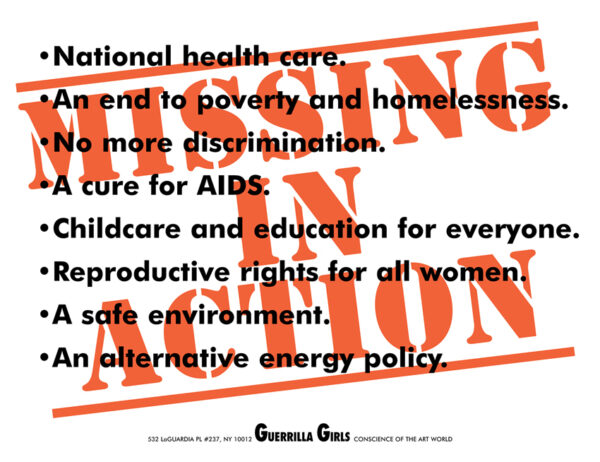
Guerrilla Girls, Missing in Action, 1991, poster. Copyright © Guerrilla Girls. Photo source: https://www.guerrillagirls.com/projects
All of the items listed in Missing in Action remain on progressive agendas. In many cases, we are actually worse off today than thirty years ago. Women’s reproductive rights are under unprecedented assault, with a Supreme Court stacked against them. Poverty and homelessness are rampant, exacerbated by massive economic inequities and the pandemic, which have put millions more on the precipice of eviction. The climate crisis appears graver with each passing day. Initiatives to substantially improve health care, expand Medicare, and pass voter rights appear to be stalled, at least for the time being. Missing in Action (M.I.A.) is a term used for soldiers lost in combat. The Guerrilla Girls here point out the losses caused by the M.I.A.s of domestic politics. In oblique fashion, the poster’s title refers to the bloated military budget that takes a disproportionate share of national wealth.
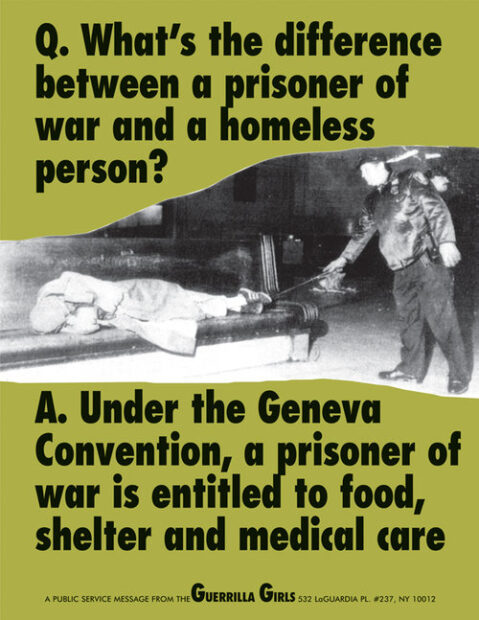
Guerrilla Girls, Q. What’s the difference between a prisoner of war and a homeless person?, 1991, poster. Copyright © Guerrilla Girls. Photo source: https://www.guerrillagirls.com/projects
This poster highlights the cruel treatment of unhoused people in the U.S.

Guerrilla Girls, George Bush, “The Education President,” 1991, poster. Copyright © Guerrilla Girls. Photo source: https://www.guerrillagirls.com/projects
This poster mocks Bush I’s education initiatives.
As bad as the first Gulf War was, who could have foreseen that this poster could have been reutilized under Bush II — or that there would even be a Bush II? The latter’s “war on terror” wrecked havoc, destabilized nations and regions, and, as a consequence, greatly multiplied the enemies Bush II sought to vanquish. And of course, on the U.S. side, the poor bore the brunt of both wars.
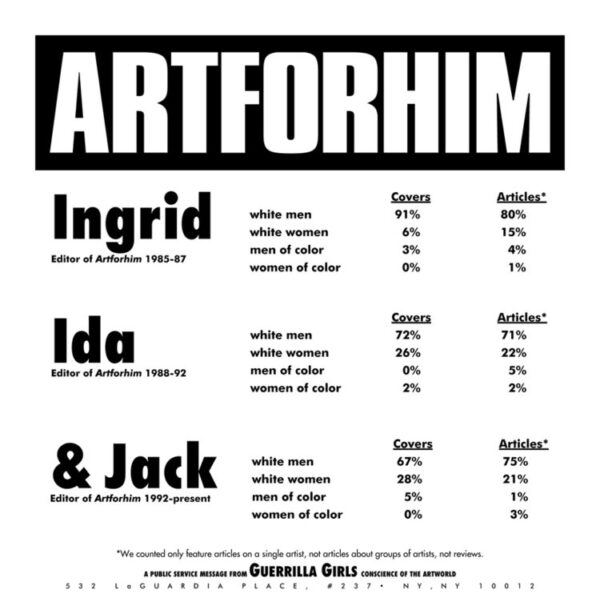
Guerrilla Girls, Art For Him, 1994, poster. Copyright © Guerrilla Girls. Photo source: https://www.guerrillagirls.com/projects
As a final sampling of the Guerrilla Girl’s early work, I illustrate this poster, which analyzes covers and feature articles devoted to single artists in Artforum, the trendiest mass circulation art magazine of its day. The GG brilliantly transformed the distinctive ARTFORUM masthead into ARTFORHIM. Their statistics are broken down into three groups (from 1985 to 1994) that correspond to the three editors-in-chief during this period, whose full names are: Ingrid Sischy, Ida Panicelli, and Jack Bankowski. White women made demonstrable progress from Sischy to Bankowski, going from 6% of covers to 28%, and from 15% of feature articles to 22% (under Panicelli) and 21% (under Bankowski). On the other hand, covers and feature articles devoted to both men and women of color hovered statically between 0% and 5% under all three editors. GG Kahlo notes in her AAA interview that Panicelli sent the group an apology letter for the coverage under her editorship. As always, the Guerrilla Girls provided stark and readily graspable visualizations of complex information.
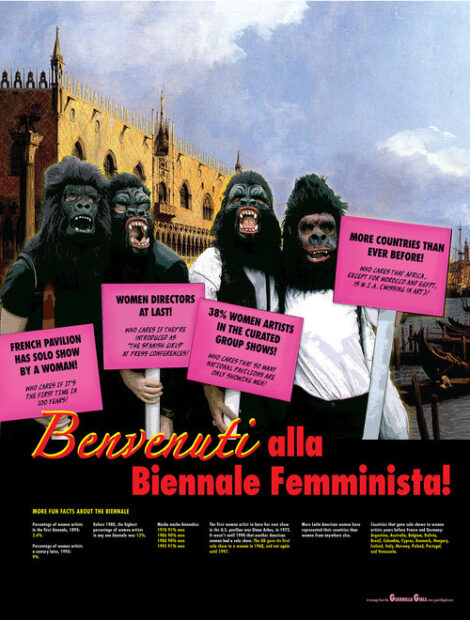
Guerrilla Girls, Benvenuti Alla Biennale Femminista!, 2005, poster. Copyright © Guerrilla Girls. Photo source: https://www.guerrillagirls.com/projects
Benvenuti Alla Biennale Femminista! (Welcome to the Feminist Biennial!) was one of six posters by the group in the 2005 Venice Biennale exhibition Always a Little Further, which was curated by Rosa Martinez. The pink signs bear sarcastic fine print. The fine print on the left reads: “Who cares if it’s the first time in 100 years!” The small print on the right says: “Who cares that Africa, except for Morocco and Egypt, is M.I.A. (Missing In Art)!”
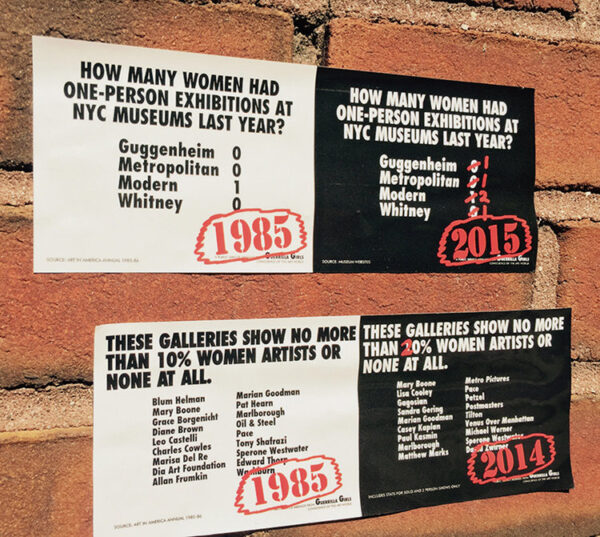
Guerrilla Girls, NYC Recount, 2015, sticker. Copyright © Guerrilla Girls. Photo source: https://www.guerrillagirls.com/projects
In the 2010s, The Guerrilla Girls revisited two works from three decades prior and updated them. They found that the major museums had made little progress in the area of one-person shows featuring women artists, with three museums going from 0 to 1, and one museum from 1 to 2. The most elite museums have been slow to accord women the important honor of a solo exhibition.
The threshold of the dishonor roll of galleries that showed less than 10% women (or none at all) in 1985 was upped to 20% (or none at all) in 2014. That’s progress of sorts, but probably much less that the Guerrilla Girls hoped for when they began their struggle in 1985. It is not easy to change powerful, stagnant institutions, or for the effects of changes to filter through all avenues of society, which is necessary to create an equal playing field.
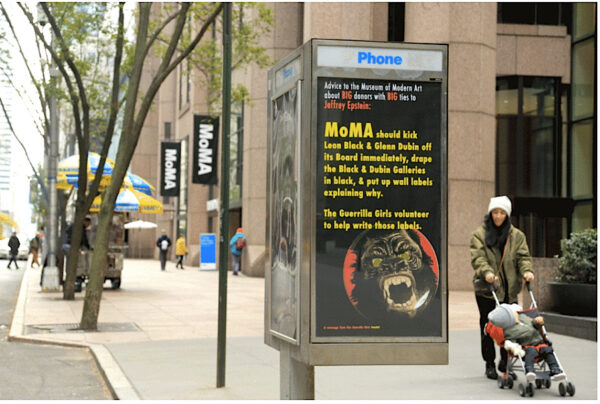
Guerrilla Girls, Jeffrey Epstein, Leon Black, and MoMA, 2019, poster on phone booth by MoMA shop (across the street from MoMA, near where the 1985 protest took place). Copyright © Guerrilla Girls. Installation in collaboration with Art in Ad Places. Photo by Luna Park. Photo source: https://www.guerrillagirls.com/projects
The Guerrilla Girls turned to MoMA again in 2019, demanding the ouster of trustees linked to the late pedophile and human trafficker Jeffrey Epstein. The Guerrilla Girls proposed draping the galleries named after these trustees in black, and volunteered to write explanatory labels. In 2021, under pressure from artists and activists, Leon Black declined to seek re-election as chair of MoMA’s board of trustees.
The Guerrilla Girls’ Radical Critique
Since the days of the robber barons, most U.S. museums — unlike national museums in most countries — have had considerable private funding and substantial private control over all aspects of the institutions. The GG view private collector/trustees as self-interested actors who do a disservice to art history:
It’s unethical that wealthy art collectors who invest lots of money in art can become museum trustees overseeing institutions that validate their investments. It’s a lousy way to write and preserve art history (quoted in GGGBB).
The Guerrilla Girls enact an institutional critique. They view museums as self-perpetuating organs of exclusion:
No more conflicts of interest or insider trading. No more cookie-cutter collections of art that costs the most. Convince art collectors their collections are inferior with only work by white male artists. Don’t let museums perpetuate this version of art and power with a few tokens thrown in. Make sure your favorite museum casts a wider net and collects the whole story of our culture (quoted in GGGBB).
The art market and the competition it engenders (in more ways than one) is a large part of the problem:
BE A LOSER: The world of art doesn’t have to be an Olympics, where a few win and everyone else is forgotten. The art market and its hyper-celebrity culture makes everyone but the stars feel like failures. But there’s another world out there that’s not about raging egos. A world of artistic cooperation and collaboration. That’s the one we joined, and we invite you to join it, too (quoted in GGGBB.)
And, finally, “Feminists like us who believe in intersectionality fight for all human rights. No one is free until everyone is free” (quoted in GGGBB).
Signs of Change within Museums
In 2012, the Guerrilla Girls explained to Interview how the art world has changed since the group’s first activities:
In the beginning, we worked in an atmosphere of disbelief: No one wanted to think the art world was anything less than a meritocracy. The kind of scrutiny applied to other fields was unwelcome. Now, it’s a no-brainer: You can’t write the history of a culture without all its voices. No curator or dealer wants to be considered a Neanderthal for not showing women or artists of color… But the commercial art world completely sucks.
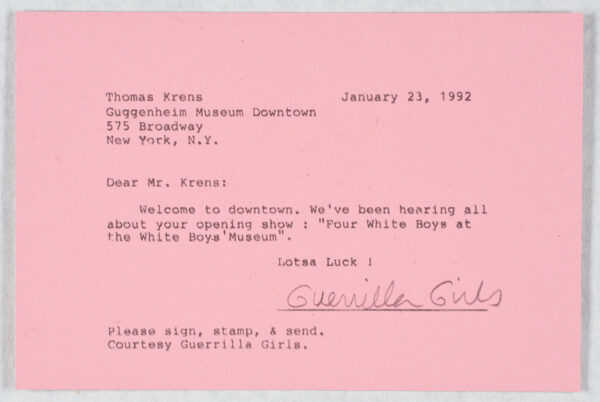
Guerrilla Girls, pink postcard addressed to Guggenheim director Thomas Krens, 1992, collection of Carnegie Museum of Art. Photo source: Carnegie Museum of Art.
The Guggenheim Museum opened the Guggenheim Museum Soho, a downtown branch designed by Isozaki (the architect who renovated the Palladium), in June of 1992 (it closed in 2001 after disappointing attendance). The Guggenheim planned to feature four male artists at its first exhibition at the Soho branch. Over the course of many months, activists urged the museum to diversify its inaugural exhibition. The GG campaigned directly with an image-free pink postcard dated January 23 with the following text: “Dear Mr. Krens [the Guggenheim’s director]: Welcome to downtown. We’ve been hearing all about your opening show: ‘Four White Boys at the White Boys’ Museum’. Lotsa luck!”
According to Robert Atkins in a March 24, 1992 Village Voice column cleverly titled “Guggenheim or Guggen-Him?,” the stack of pink postcards the institution received made management very nervous because they were still awaiting approval (that required the assent of multiple city officials and entities) to convert the building at Broadway and Prince into a museum. Manhattan borough president Ruth Messinger specifically expressed concern about diversity. In Atkins’ account, the museum was on the hot seat, and slippery comments from then-Guggenheim deputy director Michael Govan (now the director of the Los Angeles County Museum of Art) led to a spin campaign to control the damage. Atkins predicted that one or two women would be added to the Soho exhibition. He notes that Louise Bourgeois and Jenny Holzer were proposed at the March 10th Women’s Action Coalition (WAC) meeting. Bourgeois was ultimately added to the exhibition.
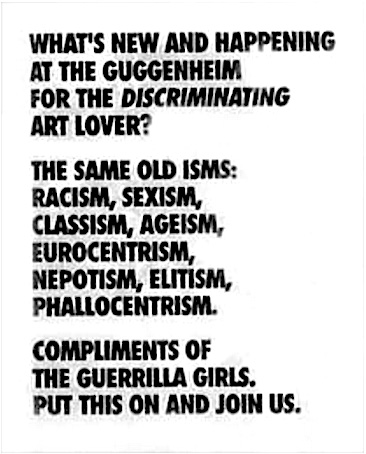
Guerrilla Girls, text on the back of the paper bag hats/masks distributed at the June 24, 1992 protest at Soho Guggenheim. Photo source: Alexander Street.
The Guerrilla Girls and the WAC (the latter disbanded in 1995) organized a joint action outside the Soho branch on June 24, 1992, where they distributed paper bag hats/masks (with a gorilla printed on one side, and text on the other) to 500 chanting demonstrators. The text makes punning use of the word “discriminating” and accuses the Guggenheim of the usual isms. Even Bourgeois donned a hat. See Alexander Street for additional photos of demonstrators wearing hats.
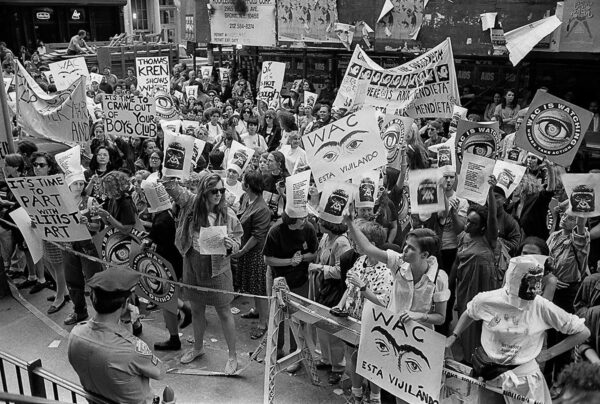
June 24, 1992 protest at Guggenheim Soho. Photo source: Lisa Kahane in “Culture Wars,” Whose Streets? Our Streets!
Chave characterizes the successful intervention at the Guggenheim Soho as a tipping point:
a moment after which no one could plan an exhibition or a slate of exhibitions in the contemporary art world any longer without considering the gender and complexion of the participants… Such self-monitoring newly became, in short, mandatory and self-reflexive.
I think Chave overstates her case. It was a turning point, but it also took place under unique circumstances. Would the Guggenheim had added Bourgeois if its permit had not been pending? Moreover, New York is unlike any other city: art plays a greater role in its economy, and in its political economy, than that of other cities. New York has enormous quantities of activists and artists, a highly developed alternative art press, local and state politicians who fund and regulate museums and who are receptive to political pressure, museums have trustees that represent districts and/or the public interest (not merely rich collectors), etc. Without minimizing the importance of the victory at Guggenheim Soho, many subsequent calls for diversity fell on deaf ears in cities around the country, and in New York itself.
In 2007, the GG worked in conjunction with the Washington Post on the project Horror on the National Mall, which crunched the numbers on representation at museums on the Mall in Washington, DC. According to GG Kahlo in her AAA interview, the museums were “shocked” when they were confronted by the very information that they had provided to the Post, once it was broken down into percentages.
Even more astonishingly, the National Gallery of Art did not have a single work by an artist of color on view. When the Post called the National Gallery to fact check before publication, the museum hurriedly put up a Martin Puryear sculpture, so that they would have one work by an artist of color on view. GG Kahlo adds that after the article was published, a group of female curators at the National Gallery dubbed themselves the Gallery Girls. Lacking faith in the museum’s initiative, they took up a collection among themselves and purchased works by the Guerrilla Girls for the museum. Chave emailed the National Gallery in 2010, inquiring whether it had any initiatives to diversify its collection, and received what she terms “a would-be anodyne assurance” that lacked substance.
Significant changes are at last underfoot at the National Gallery. Kaywin Feldman, the museum’s first woman director, was hired in 2018. Earlier this year she declared: “I was hired with a clear mandate from the board to put the national back in the National Gallery of Art” (Zachary Small, “National Gallery of Art Reopens With a New Vision: ‘For All the People,” New York Times, May 13, 2021).
Feldman also told the New York Times: “I inherited a leadership team that was 100 percent white, and now it’s 57 percent people of color.” She hired E. Carman Ramos — a Latinx specialist from the Smithsonian American Art Museum — as chief curator, and also hired Kanitra Fletcher as associate curator of African-American and Afro-Diasporic art.
Preparations have been made for several diverse exhibitions and installations. Darren Walker, president of the Ford Foundation, a $13 billion social justice-oriented philanthropic organization, who became a National Gallery Trustee in 2019, calls collection diversification a top priority. According to the Times, the museum’s collection is currently nearly 97% White and 92% male (this is after the contributions of the Gallery Girls, the absorption of about 40% of the Corcoran Museum’s collection following its dissolution, and the museum’s recent diversification acquisitions).
On a recent trip to Northeastern museums, I witnessed so many changes from my last pre-pandemic visit that I almost felt as though I were a time-traveler.
New York City
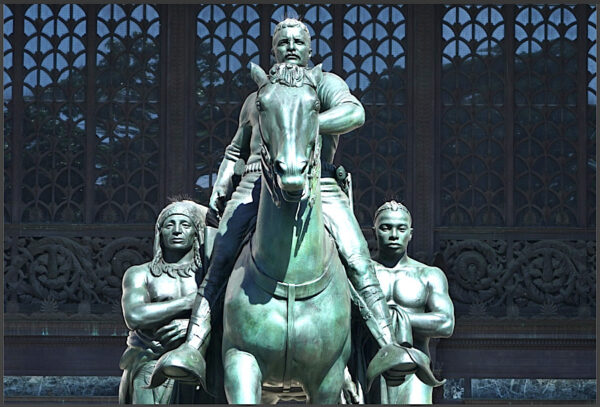
James Earle Fraser, The Theodore Roosevelt Equestrian statue (detail), commissioned in 1925, unveiled in 1940, The American Museum of Natural History. Photo source: Teen Vogue, Timothy A. Clary.
The Museum of Natural History in New York requested the removal of the city-owned equestrian statue of President Theodore Roosevelt (flanked by a Native American and a Black man, who are on foot) from the entrance to the museum. As noted by Angie Jaime in a Teen Vogue newsletter dated June 20, 2020, the activist collective Decolonize This Place has been agitating for the statue’s removal for several years. A statement on June 21, 2020 noted that the killing of George Floyd had a galvanizing effect on the museum. It made this unambiguous declaration: “many of us find its depictions of the Native American and African figures and their placement in the monument, racist.” A June, 2020 New York Times article discusses some of Roosevelt’s offensive views. The statue will be exiled to Medora, North Dakota (population 126), where it will be displayed near the Theodore Roosevelt Presidential Library, which is scheduled to open in 2026.
Inside the museum, I saw the documentary exhibition called Addressing the Statue. The museum also engaged in a self-critique of its outmoded diorama display that depicts the Dutch colonization of Manhattan. This criticism took the form of new labels as well as texts applied directly to the glass. An additional placard notes that all of New York City was once Lenape territory.
Across Central Park, the Metropolitan Museum of Art’s annual report (July 1, 2020-June 30, 2021), released on November 10, 2021, detailed a host of diversity initiatives, beginning with the appointment of its first Chief Diversity Officer, Lavita McMath Turner. It noted equity and antiracism training at all levels within the museum. Half of its hires for “key roles” during the year were reportedly people of color, including Patricia Marroquin Norby, its first curator of Native American art.
The Met has created an endowment to support the acquisition of works by contemporary BIPOC artists (see Constance Grady, “Why the term ‘BIPOC’ is so complicated, explained by linguists,” Vox, June 30, 2020). The report states that the museum’s libraries have significantly expanded their holdings of materials pertaining to Blacks, and they are “currently replicating this model to other marginalized demographics, including LGBTQAI+ and Indigenous, Latinx, and other non-white artists.”
The museum is also “rethinking [their] permanent collection displays to highlight new narratives.” A text in an old master gallery, for instance, discusses the development of race-based slavery and its economic benefit to Europeans, including France, which banned slavery within its own borders at the same time that it profited enormously from slave plantations in its colonies.
The Charles and Valerie Diker Collection of Native American art is situated in the American Wing, marking a move to a geographical system of organization. Native American works, and those from the ancient Americas, Africa, and Oceania were initially grouped together in a wing that opened in 1982. Having absorbed Nelson Rockefeller’s Museum of Primitive art, the Met’s new department that oversaw this wing was initially called the Department of Primitive Art. Despite this extremely problematic terminology, the new wing influentially broadened the canon of art in U.S. museums. The Met’s nascent colonial Latin American collection is also housed in the American wing.
Due to the pandemic, I missed the Making The Met, 1870 – 2020 exhibition, which celebrated the museum’s 150th anniversary, so I cannot assess how successfully the staff reconsidered and rewrote some of its exhibition texts in response to the Black Lives Matter movement. I did experience the Surrealism Beyond Borders exhibition, which spanned nearly eight decades of work across 45 countries. In the show, I discovered many artists that were new to me. As noted above, I also saw the political graphics exhibition that featured the Guerrilla Girls’ poster. Regretfully, Before Yesterday We Could Fly: An Afrofuturist Period Room, was not yet open, but I take solace in Hyperallergic’s brutal takedown of a reactionary critic who panned the exhibition.
The multi-media installation Adam Pendleton: Who Is Queen? in the five-story atrium of the Museum of Modern Art includes — among many other components — images projected onto a base that once supported an equestrian statue of Robert E. Lee in Richmond, Virginia. In this work, the Black, gay artist seeks to articulate “the ways in which we simultaneously possess and are possessed by contradictory ideals and ideas.” Ann Temkin, Chief Curator of Painting and Sculpture at MoMA, continues to select diverse works to rotate within the permanent collection galleries. MoMA’s collection is so rich that I have always hoped they would enter into a partnership with the Brooklyn Museum and build a space that enables them to show much more of their collection.
Providence, R.I.
The Rhode Island School of Design Museum has opened a number of small galleries that feature a diverse selection of artists and media. I encountered several unfamiliar contemporary artists, as well as many works that had previously languished in storage. Since I had not been to Providence for a number of years, I saw Martin Puryear’s Slavery Memorial (2014) on Brown University’s campus for the first time on this trip. An accompanying text acknowledges that the university profited from slavery.
Boston/Cambridge
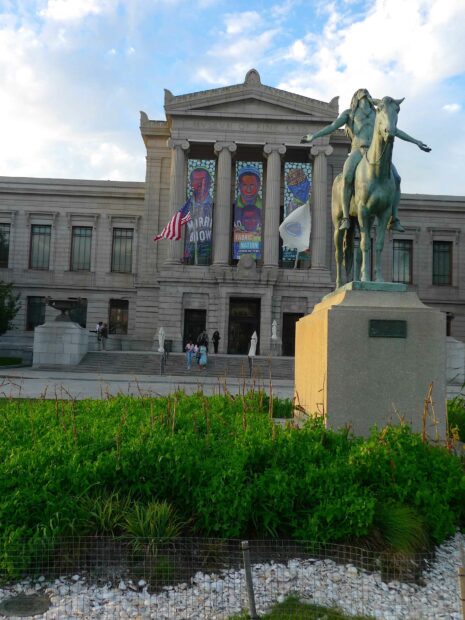
Façade of the Boston Museum of Fine Art with banner for the Fabric of a Nation exhibition. Elizabeth James-Perry’s organic installation, Raven Reshapes Boston: A Native Corn Garden at the MFA, surrounds Cyrus Dallin’s bronze sculpture Appeal to the Great Spirit (1909). Photo source: Ruben C. Cordova
The exhibition Women Take the Floor, a “take-over” of the top floor in the Art of the Americas wing at the Boston Museum of Fine Art, focuses on “the overlooked and underrepresented work and stories of women artists.” It begins with a double portrait by Frida Kahlo that also serves as the cover of the museum’s current handbook. An important collection of Pre-Columbian and Native American art is on the bottom floor of the Americas wing, between its display of colonial silver and folk art.
The museum’s commitment to diversity is evident in several other exhibitions. Black Histories, Black Futures, an excellent exhibition curated by teens in partnership with youth empowerment organizations, is given pride of place in the atrium under the MFA’s dome. Paper Stories, Layered Dreams: The Art of Ekua Holmes features vibrant collaged book illustrations by a community activist from the Roxbury neighborhood. The exhibition Fabric of a Nation: American Quilt Stories underscores the “underrecognized diversity of artistic hands and minds… including female and male, known and unidentified, urban and rural makers; immigrants; and Black, Latinx, Indigenous, Asian, and LGBTQIA+ Americans.”
Elizabeth James-Perry, an Aquinnah Wampanoag, created her installation Raven Reshapes Boston: A Native Corn Garden at the MFA by planting corn, beans, and sedges in traditional Woodlands Native American mounds around Cyrus Dallin’s sculpture. The white border of crushed oyster shells references the artist’s coastal identity. James-Perry calls her installation “a reclamation of Boston as indigenous land.” The museum website calls her organic installation a “counterproposal to the misrepresentations and erasures” embodied in Dallin’s statue.
The Isabella Stewart Gardner Museum’s exhibition Titian: Women, Myth, and Power unites six storied paintings of mythological subjects by Titian that deal with nudity, violence, and rape. The museum commissioned the video performance The Rape of Europa by Mary Reid Kelley and Patrick Kelley as a response to Titian’s painting of the same name. In the video, Europa is endowed with a voice. The Gardner also commissioned Barbara Kruger’s Body Language. Kruger’s piece utilizes two overlapping details from Titian’s Diana and Actaeon to raise issues of vision, power, and sexuality.
Finally, at the Harvard Art Museums, a multi-year project called ReFrame — which aims to tell diverse stories — launched on September 4, 2021 when the museums reopened to the public. A large Kehinde Wiley triple portrait (on two-year loan) greets visitors at the entrance to the art museums, replacing a Max Beckmann triptych. A fascinating video installation by Krzysztof Wodiczko called Portrait utilizes three projected images of Harvard’s portrait of George Washington by Gilbert Stuart in a dark room. These images — which seem to be in dialogue with one another — give voice to a diverse group of local students and community members. While recordings of the youths play, their faces — including lips that seem to be speaking — are partially superimposed over the three images of the Stuart painting.
Conclusion
The Black Lives Matter movement has sent shockwaves through the country’s institutions — including museums — and served to greatly accelerate diversification efforts. Many forces have played a role in the art world, including ethnic museums and constituencies, multiple women’s groups, practitioners of institutional critique from Hans Haacke to Occupy to Decolonize This Place, politicians, etc. One should also acknowledge the very significant — and continuous — role played by the Guerrilla Girls in creating the conditions for diversification. They have utilized remarkable analysis, tactics, and presentation to keep important issues at the center of debate since 1985.
***
Ruben C. Cordova is an art historian who has curated more than thirty exhibitions and written or contributed to nineteen catalogues and books.



8 comments
Ruben, you really opened my eyes to the GG movement. I had no idea it was so international!!
Thanks for enlightening me.
You are welcome, Nancy. They enjoyed touring to spread their message, and lecture fees were an important source of income. The GG have also always been very popular, so they have been in high demand. In Texas, the coverage they received has tended to be oriented to local events, so I wanted to note the breadth of their reach.
Great article Ruben! Thank you
You are most welcome, Gaspar. I always wanted to write about the GG, and once I saw that the Met had acquired “Do women have to be naked to get into the Met. Museum?,” I got to work right away.
Thanks for this excellent article!
You are welcome, Carolyn. I enjoyed researching and writing it.
Pleaase forward to Ruben: from the Guerrilla Girls
Dear Ruben:
Thanks so much for the thoughtful article about our history protesting discrimination and corruption in the art world and its relationship to changing museum practices.
It’s been a crazy and wonderful ride for the last 36 years. Our collective has done hundreds of projects all over the world and has been through every situation that happens in any long term relationship, multiplied by 65, (the number of members who have been in and out of the group, not the 100 that has been claimed). Thanks for your understanding and close reading of our work and our words.
A couple of things we would like to point out, however:
Our group has always been the Guerrilla Girls. Our name is not Guerrilla Girls Inc. The break off groups are incorporated, too (Guerrilla Girls Broadband Inc., and GuerrillaGirls On Tour, Inc.). Incorporation is just the way groups have to function legally and financially. We ask that you please refer to us by our actual name, Guerrilla Girls.
As far as we know, we were responsible for the website exhibition at the Nasher, not GGBB.
We didn’t out ourselves publicly. Jeffrey Toobin did. Like in a divorce, in order to settle our split with GGOT and GGBB, we had to file a legal suit to bring them to the table. To get the justice we all deserved, Kathe and I had to tell the courts who we were. Jeffrey Toobin, in his attempt to paint us as warring feminists engaged in a catfight, went to the court, found the filed papers and outed us. As we know of late, Jeffrey has a reputation for “revealing ” too much.
As a footnote to the above, we have a policy to honor any of our members who pass away with a memorial on our social media. You can find the names of our deceased and greatly missed members there. Some living former members have chosen to out themselves for all kinds of reasons. If you look hard enough you will find them. But it doesn’t matter. No one really cares who we are anymore.
One final bit of design trivia: the typeface we used from the beginning and still use today is Futura Extrabold Condensed, not Helvetica.
Thanks again for your article. Hope to meet up with you someday. Don’t forget to check out our latest: http://malegraze.com/
Best,
Frida Kahlo for the Guerrilla Girls
Dear Frida,
It is so wonderful to hear from you. It is not often that I hear from a living legend. I am so glad that you liked the article, and I would very much like to meet you and the other Guerrilla Girls, too.
I will make changes in the body of the text to incorporate your comments. I shall place your definitive total of 65 members after Stein, et al’s estimate of 100. After Susan Tallman’s “generic” Helvetica quote, I will note that the GG in fact used Futura Extrabold Condensed. I love your Toobin quip and will incorporate it as well.
I will find out who was responsible for the Nasher online exhibition, and I shall drop the “Inc.”
I am very glad to hear that the GG members who have passed on are being memorialized.
And of course, I look forward to the GG’s new work!